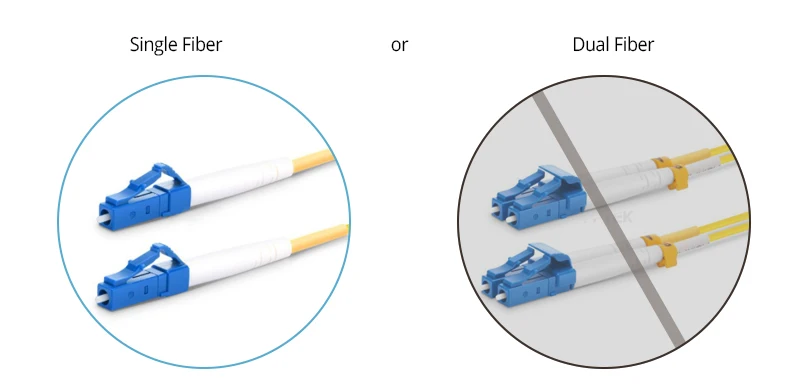

 Knowledge Base +
Knowledge Base +  2024.01.10
2024.01.10BiDi SFP means bidirectional small form-factor pluggable transceiver. The most distinct characteristic of the bidirectional SFP transceiver is that it is able to achieve bidirectional fiber optic communication by operating on a single fiber. Based on WDM (Wavelength-Division Multiplexing) technology, BiDi optics are able to split different wavelengths of light paths through an integrated wavelength-division multiplexing splitter of BiDi SFP transceivers.
Here are some key advantages of BiDi SFPs:
Single Fiber Strand for Two-Way Communication:
BiDi SFPs use a single fiber strand for both transmit and receive directions. This is achieved by employing different wavelengths for upstream and downstream communication on the same fiber, allowing bidirectional communication over a single fiber link.
Increased Fiber Utilization:
By using a single fiber strand for bidirectional communication, BiDi SFPs effectively double the capacity of existing fiber infrastructure. This can be particularly beneficial in situations where available fiber strands are limited or expensive to install.
Cost Savings in Fiber Deployment:
The use of BiDi technology reduces the number of fiber strands needed for a network deployment, resulting in cost savings on fiber optic cabling, installation, and maintenance.
Simplified Fiber Planning:
BiDi SFPs simplify network planning and design by reducing the number of fibers required. This can be advantageous in scenarios where fiber resources are constrained, such as in metropolitan area networks (MANs) or within buildings.
Ease of Migration and Upgrade:
BiDi SFPs can be deployed in existing fiber infrastructure, allowing for a cost-effective upgrade to higher data rates or additional capacity without the need to install additional fiber strands.
High Performance and Reliability:
BiDi SFPs offer high performance and reliability, making them suitable for various applications, including telecommunications, data centers, and enterprise networks.
Compatibility with Existing Fiber Infrastructure:
BiDi SFPs are designed to be compatible with standard SFP ports on networking equipment. This makes them an easy and flexible solution for upgrading or expanding existing networks without significant changes to the infrastructure.
Distance Flexibility:
BiDi SFPs are available in different variants with varying distance capabilities, accommodating a range of distance requirements from short-range to long-range connections.
Wavelength Division Multiplexing (WDM) Technology:
BiDi SFPs leverage WDM technology to transmit and receive data on different wavelengths within the same fiber strand. This enables efficient use of the available bandwidth and supports bidirectional communication.
It's important to note that while BiDi SFPs offer these advantages, they are most effective in point-to-point connections, and their use may be subject to specific compatibility considerations. Always refer to the manufacturer's specifications and compatibility guidelines when deploying BiDi SFPs in a network.
As the above-mentioned introduction about BiDi SFP, we have learned the modules separate different transmission wavelengths over a single fiber to achieve optical communication. To elaborate, the single-fiber bidirectional SFP transceivers must be used in pairs, as depicted in figure 2. At one side a 1000BASE-BX10-U (Tx1310nm/Rx1490nm) BiDi SFP transceiver transmit a 1310nm wavelength optical signal and receive a 1490nm optical signal while the opposite side of the single-fiber bidirectional link 1000BASE-BX10-D (Tx1490nm/Rx1310nm) BiDi SFP transmit a wavelength of 1490nm and receive a 1310nm optical signal conversely. The integrated optical component of WDM couplers plays a critical role in bidirectional fiber optic communication.

Figure 2: Working Diagram of BiDi SFP
Different from the common SFP transceivers, which are typically designed with two ports, one for transmitting signals and the other one for receiving signals, BiDi SFP has only one port for both transmitting and receiving based on WDM technology. Consequently, BiDi SFP uses only one single fiber while the common SFP optical transceivers need duplex fiber to achieve fiber optic communication.

Figure 3: Single fiber BiDi SFP or Dual Fiber
Generally, BiDi SFP is designed to support link lengths of 10km to 120km. For fiber optic cable, the signal is transmitted as a light impulse in the fiber and bounces off the fiber cladding. Signals will be partly lost during the bouncing process. The smaller core is able to minimize this bouncing signal loss and allows a longer transmission distance, so single-mode fiber is typically used in BiDi optics links for its smaller diameter core of 9um compared with 50um of multimode fiber (OM2).
However, whether the existing multimode fiber used in the short-range distance connections can be used to connect BiDi transceivers? The answer is yes. QSFPTEK lab has carried out a few tests to confirm it by using a pair of 1310nm/1550nm BiDi SFP transceivers. The testing result shows they operated well within 320m transmission distance via multimode OM2 cable but ended up with bit failure rates in the longer distance. Consequently, BiDi SFP can be used in multimode fiber connections, but it is suggested that the transmission distance should be no more than 300 meters.

Figure 4: 1000BASE-BX-U BiDi SFP connects 1000BASE-BX-D over a single fiber
Subscribe to the newsletter
for all the latest updates.
2-5# Building, Tongfuyu Industrial Zone, Aiqun Road, Shiyan Street, Baoan District, Shenzhen. China
